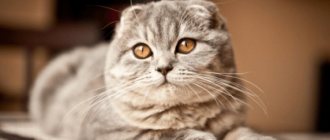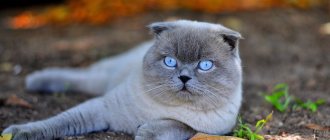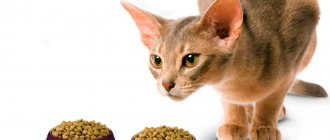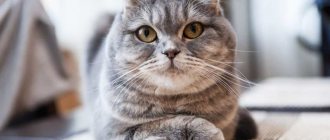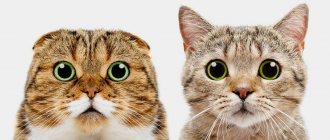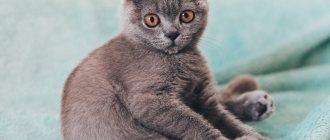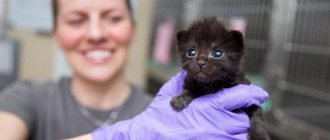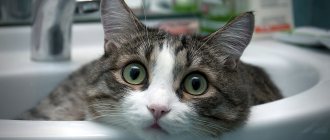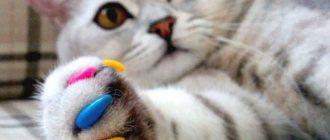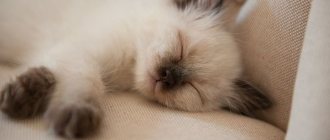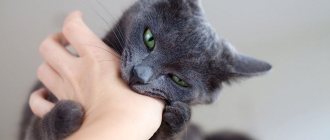The cat's immunity and health largely depend on the nature of its diet. If the body receives enough microelements and if the predator does not suffer from indigestion, it will better resist infections and is less likely to end up in the veterinary clinic due to urolithiasis or some other disease. Therefore, the issue of feeding a cat must be approached with all seriousness. What should be the proper nutrition for Scottish cats? What do Scottish cats eat? How to properly feed Scottish Folds, Scottish Straights, Highland Folds and Highland Straights?
Article continues after advertisement
How to properly feed a Scottish cat? The diet of an adult Scottish Fold and Straight-eared cat per day is 200-250 grams of food. Portions must be calculated individually: the daily dose is 3-5% of the animal’s weight. Translated into energy terms, a cat's diet has a value of 335 kilojoules. This is an average figure, because cats have different levels of activity. So, kittens, pregnant and lactating cats, as well as cats during the breeding period need 10% of their weight. For castrated, overweight, elderly and inactive cats, 2-3% is enough.
We figured out how much a cat should eat. Now let's figure out what and how to feed a Scottish and British cat at home. If in the case of ready-made food you need to follow the instructions, then you will have to balance natural food yourself.
Also, what to feed the Scottish Fold and Straight-eared depends on the presence or absence of intolerance to certain foods: if there is intolerance, this product is excluded from the menu forever. Therefore, it is easier to balance natural nutrition than factory food, because the second contains a lot of different ingredients.
Let us immediately note that cat nutrition is a very young science: it is only about 15-20 years old. Therefore, there are many unexplored issues in this topic, and even enlightened people (breeders, veterinarians and zoologists) can argue among themselves with foam at the mouth about what should be added to the cat’s diet and what should not be added, and in general about what it is like. - proper feeding. However, there are basics, which we will talk about in this article. We will not say everything that can be said, but we will give guidelines.
An excursion into the physiology of cats
The main mistake of many owners is that they believe that the human and cat organisms are very similar. In fact, humans are omnivores, and cats are obligate (“obligate”) carnivores. This means that her diet consists mainly of animal products. The stomach and short intestines of cats (2.1 meters long) easily digest proteins and fats of animal origin, but they hardly need carbohydrates.
To quickly break down proteins and destroy bacteria, a pH of 1-2 is maintained in the stomach of cats, that is, the environment is much more acidic than in the stomach of omnivores. Proteins of animal origin are considered complete for cats (containing all the necessary amino acids), and proteins of plant origin are considered incomplete. Animal proteins are found in meat and dairy products, as well as eggs. A cat's protein requirement is 40-60% of its daily diet.
Article continues after advertisement
Fats in a cat's diet are an important component: the recommended fat content is on average 15% of the daily diet, the minimum acceptable threshold is 5%, the maximum acceptable threshold is 20%. Cats, unlike humans, do not have cholesterol problems and do not suffer from heart disease due to the increased level of animal fats in their food. They need fats to obtain energy and supply fatty acids to the body (in particular, Omega-3 and Omega-6). A lack of animal fats in the diet leads to a huge number of health problems. But vegetable fats are almost useless for cats in terms of absorption of nutrients. However, they can be added drop by drop to food.
As for carbohydrates, it is worth knowing: cat saliva does not contain the amylase enzyme necessary for their digestion. And there are no enzymes at all: food passes through the oral cavity very quickly and is swallowed. In order for the carbohydrates that enter the body to be broken down, the pancreas has to work. They are broken down by its enzymes in the small intestine to glucose and other monosaccharides. If there are too many carbohydrates in the diet, then the pancreas is forced to work to the limit. But this does not mean that if you put 50% carbohydrates in your food today, your cat will get sick tomorrow. The cat's body has high compensatory capabilities and an unbalanced diet leads to consequences only if the cat sits on such a diet for a long time.
It should be noted that some breeds react less critically to an imbalance of substances in the diet, others more so. So, for example, a purebred Briton (with no Scots in his family) belongs to the first group of animals, and Scots, who often have problems with the absorption of microelements, belong to the second group.
Although a cat's body can almost completely do without carbohydrates (it can get energy from fats and proteins), in a home-based diet you can provide your pet with a small amount of them. First of all, this is necessary for easy energy production and stool formation (fiber from vegetables helps remove hair and toxins from the body and creates a feeling of satiety). Also, carbohydrate products (greens, brewer's yeast, cabbage (you can give a pinch of grated cabbage if the cat does not have gas from it) contain prebiotics that help the growth of beneficial intestinal microflora.
An experiment was conducted in which the tailed animals were asked to choose any of the proposed products. On average, cats chose the following ratio: proteins - 52%, fats - 36%, carbohydrates - 12%. The figure recommended by scientists for cat fats has been slightly overdone, but it is worth considering that the numbers are averaged and are given as a rough guide.
Thus, the physiology of a cat requires a diet consisting almost entirely of animal proteins and fats. For those who would argue that cats have been living with humans for a long time and should already have evolved to suit their type of diet, here is the opinion of zoologists: the physiology of domestic cats has changed little since domestication and is not very different from the physiology of their wild counterparts.
What not to feed
The health of your pet depends not only on a properly formulated diet, but also on knowing what not to feed your Scottish Fold or Straight-eared cat.
It is strictly forbidden to include the following products and additives in the diet of a fold-eared, straight-eared Scottish kitten:
- Any types of sweets and confectionery products lead to obesity
- It is unacceptable to feed Scottish Straight and Scottish Fold kittens chocolate.
- Lard, fatty meats and fish affect the liver;
- Adding salt, hot spices, pickles and marinade to food harms the kidneys and stomach;
- Fried, smoked meat and fish are poorly digested and harm the pancreas;
- Canned food contains salty, peppered foods with spices that are harmful to digestive and urinary function.
Important! Do not teach your Scottish cat to eat anything from the common table; such food is harmful to the pet’s health and develops bad behavior habits.
Advice from veterinarians
Veterinarians' advice on what to feed Scottish fold and straight-eared cats:
- Before purchasing a beloved pet, it is useful for owners to:
- get acquainted with the peculiarities of feeding Scottish fold and straight-eared kittens;
- Find out at the cattery what Scottish cats eat at birth and in what quantities.
- When feeding Scots, it is beneficial to use ready-made, high-quality specialized feed:
- Practically, it is much easier to acquire a solid supply of feed;
- Ease of use, no need to cook food;
- Cost-effective, it is more profitable to purchase balanced feeds than to buy the entire range of products separately.
- Long shelf life, unlike natural products.
Pets, Scottish fold and straight-eared cats, need proper and balanced nutrition. It is important from the first days of a kitten in the house to organize care, to take into account the nuances of nutrition during the growth of the pet at all stages of development, taking into account the characteristics of the breed.
Natural and ready-made food
While you don’t know what Scottish Fold and Straight-eared cats eat, as well as British cats, we will say a few words about the two types of food. You should choose one of them that is closer to your lifestyle and strictly adhere to it.
The first type is natural food. But this is not food from the master's table. This is separately prepared food for the cat from certain types of meat, vegetables and dairy. Products are served without salt and spices, which are prohibited for cats. Natural nutrition must be balanced so that it contains all the necessary substances. And when feeding cats naturally, it is advisable to take courses of vitamins: this guarantees that all the microelements they need will enter the body, even if the owner has not prepared the diet correctly. Although, if everything is done correctly, and useful organic supplements are offered for food, then there is no need for synthetic vitamins. Moreover, they are absorbed worse than natural ones.
What else can you feed your Scottish cat? The second type of nutrition involves the use of ready-made food - canned food, bags and dry pads. High quality food is made in factories from similar products that we use at home. But the food is adapted for long-term storage, so you cannot call it flawless: long-term storage requires the addition of preservatives and not entirely useful substances. In addition, many feed manufacturers, in an effort to save money, use products of dubious quality.
Article continues after advertisement
EXPERT COMMENT: Yulia Prishchepa, presenter of the YouTube channel about cats “Athena-TV”
What to choose - natural food or ready-made food?
Natural food is most suitable for a cat, but you need to clearly know what can be given and what absolutely cannot be given. Also, with a natural feeding scheme, it is difficult to balance foods. For example, you need to know that if you feed your cat only raw meat, this can lead to serious health problems. Therefore, if you are a busy person or have many cats, a ready-made balanced food will suit you. If you have 1-2 cats and have time to study the intricacies of dietary nutrition, you can choose natural ones.
Selecting your diet
For all cats, including purebred Scots, three types of food are recommended:
- Homemade food with a variety of natural products.
- Industrial with ready-made food, dry or jelly-like.
- Mixed feeding, homemade food divided over time, alternating with ready-made food.
Each type of food is correct, the main thing is to follow the diet, the number of meals depending on the age and physical condition of the animal. It is important that food for Scottish kittens is always fresh, varied, and provides the necessary balance of vitamins and microelements.
When choosing the type of food, they are guided by the pet’s preferences, as well as the owner’s ability to devote a lot of time to preparing homemade food.
Menu and diet for Scottish cats
Food is served in the form of pieces - small or large, if the animal can tear them. Minced meat, jellied meat and liquid food are not suitable for healthy Scottish cats.
Below is a menu of natural food, which is preferable. Let's list the foods that an adult cat's diet should consist of. So, what can you feed fold-eared and straight-eared cats?
Meat (obligatory and main product)
Low-fat varieties of meat are suitable for Scottish and British cats, because... The pancreas cannot cope with excess fat, resulting in pancreatitis. Lean meats include chicken, rabbit, quail, horse meat, turkey, and some parts of beef. The ideal meat for cats is poultry and rabbit. Pork should not be given raw.
Breeders also recommend chicken. At the same time, the MURKOTIKI website, after consulting with nutritionists, does not recommend chicken that you are not sure about. According to doctors advising the site, chicken, especially broilers, contains many hormones that are fed to poultry in factories and even in households. Plus other harmful substances. Therefore, it is better to prefer turkey meat to chicken as a more environmentally friendly product. If you have access to environmentally friendly chicken, then you can and should use it.
Meat is given raw (preferred option) or boiled, but in no case fried or smoked. Whether to feed a Scottish or British cat raw meat is up to each owner to decide for himself. On the one hand, cooking kills many beneficial substances. On the other hand, raw meat sometimes contains worms, which do not always die during the obligatory three-day freezing in the refrigerator before serving to the cat. Feeding without freezing, that is, fresh meat, is prohibited.
It is worth noting that meat grown on an industrial scale most often does not contain worms. According to experts, animals in factories are prevented and fed special food, so the risk of infection is minimized. But if you give your cat hunting or farm meat, there is a possibility of infection. Not every farmer regularly prevents their animals, and they sometimes eat food that may be contaminated. Of course, this does not apply to all farms.
It is advisable to place the meat in a bowl in the form of pieces and large pieces so that the animal strengthens its chewing apparatus.
Bones are also regularly added to the diet. They are useful because cats use them to brush their teeth, and also because in the process of eating meat from a bone, or just a large piece of meat, the tailed cats develop their jaw muscles. In addition, bones contain useful substances. For this reason, an adult cat does not need to be constantly given minced meat or small pieces of meat, because... this will cause the muscles to weaken. In addition, adult cats love meat in tangible pieces more. “MURKOTIKI” has prepared a separate article on how to feed cats meat with bones, because... This is an important issue: failure to follow the rules can lead to the death of the animal!
Article continues after advertisement
Cats on a natural diet usually go to the toilet once a day or once every 2 or even 3 days - these are normal options. But you need to monitor the stool: if the cat is prone to constipation, up to 5-10% vegetables and (or) bran are added to the meat (some add porridge, but this is wrong). A cat's complete digestive cycle takes 24 hours.
Mixes are recommended as daily food for cats: pieces of meat, offal, oatmeal, raw vegetables (carrots, broccoli, pumpkin, zucchini, etc.), herbs, raw quail eggs. This mixture is prepared in advance, then frozen in the freezer in separate portioned bags, after which it is defrosted as needed, brought to room temperature and served to the pet. The meat in this mixture is raw.
Mixes are an alternative to monofeeding, when different types of meat are not mixed in one meal. Instead, they are served at different meals. This should not be confused with constantly feeding one type of meat: this is not considered a balanced diet. According to veterinarians, both mixes and monofeeding have a right to exist. The advantages of monofeeding are a happy pet, rapaciously devouring whole pieces of meat, as well as the confidence that the gastrointestinal tract will not be confused by incorrectly selected ingredients (for example, a cat may be allergic to one of the ingredients in the mix). The advantages of mixes are that the cat receives all the necessary nutrients in every meal and there is no need to draw up and keep in mind a feeding schedule.
We recommend storing excess meat in the freezer. It is advisable to pre-cut them into portioned pieces so that you can take them out one at a time.
Bran (controversial product)
Porridges are not a recommended food for carnivores, because... They are practically not absorbed and even interfere with the absorption of nutrients from other foods. With frequent consumption of grains (porridge), cats are at risk of diabetes, urolithiasis, and thyroid problems. It is better to prefer bran to porridge.
A cat can also get grains from special grass that is sprouted in a pot. The collections usually consist of wheat, barley, millet, etc. The grass is rich in vitamins and also helps the cat move the fur that has gotten into it through the gastrointestinal tract. If it is difficult to move it forward, then the cat vomits after the grass - and the fur comes out through the mouth. Therefore, every cat must have free access to grass. Just don’t bring it from the street: wild grass can contain parasites and infections.
Fish (optional)
Cats and fish are an established stereotype that has become the basis of more than one commercial. But, in fact, fish should not be a frequent guest on the cat’s table: once a week - no more. If there is an excess of fish food, kidney problems may develop, and the cat will also begin to prefer only fish products, neglecting healthier food.
Cats can only eat boiled sea fish; river and raw fish are prohibited. Firstly, such fish almost always contain parasites. Secondly, it contains a number of substances that negatively affect the digestibility of beneficial elements. Even those owners who allow the consumption of raw meat do not feed cats raw fish. Although there are some fans of a raw food diet who serve all products in an unprocessed form.
It is important to choose the right type of fish. It should not be overly oily. And it is worth considering that many types of fish (carp, pike, bream, whitefish, smelt, minnow, chub, catfish, gukuchan, ide, herring, herring, capelin, sardinella, smelt, crucian carp, perch, tench, burbot, chebak, sprat , sprat, anchovy, sorog, bream, Argentina) contain the enzyme thiaminase, which destroys vitamin B1. You can eat such fish, but not often. But you should not feed fish from the cod family, because it develops iron deficiency anemia and hair depigmentation. Salmon fish (salmon, pink salmon, trout), as well as hake, catfish, mackerel, sawfish, tuna, etc. are good for cats.
Seafood (as a treat)
Many cats happily eat squid, shrimp, mussels and rapana. Such food is not so easy for the cat’s body to digest, so it should not be the rule, but an exception in the form of a treat: once or twice a month is enough.
Article continues after advertisement
Dairy products (recommended product)
Low-fat fermented milk products (kefir, fermented baked milk, yogurt, unleavened cheese, whey, cottage cheese) are good for the health of cats: they contain a lot of protein, calcium and vitamins, and also help good digestion. It is undesirable to consume fatty dairy products, such as sour cream, in large quantities, because... this can negatively affect pancreatic health.
Let's talk separately about milk. It is not advisable to give it to adult cats. From about 3 months they develop lactose intolerance. If you want to please your pet, because... he loves this product, buy special milk or cream for cats. Read more about milk in the diet of Scottish cats.
Eggs (a must)
Chicken yolk, as well as quail yolk and white, should be a mandatory element of the Scottish cat’s diet approximately once a week. Chicken yolk should be given raw (if you are sure of its purity) or boiled; the protein is thrown away, because It's not good for cats. But a quail egg can be given whole and raw.
Raw eggs are an excellent source of vitamins (in particular, vitamins A, D, E and group B), as well as calcium, phosphorus, iodine, iron and other trace elements.
Vegetables (optional, but recommended)
Vegetables are also good for your pet: they contain fiber, which helps avoid constipation, and vitamins. B vitamins are especially important in vegetables; cats are very easily deficient in them, since they do not accumulate excess vitamins but excrete them daily. That is, B vitamins should be supplied in sufficient quantities every day. Veterinary expert Maria Dorosh recommends including vegetables in your cat’s diet, although this is not necessary.
Vegetables can be served raw or cooked. It is necessary to take into account that vitamins are destroyed during cooking, therefore, from the point of view of saturating the body with vitamins, it is better not to cook vegetables. But the starch of boiled vegetables is better absorbed, so cooking is recommended for cats who have problems digesting food: for them, boiled vegetables are a gentler option. Once your digestion returns to normal, you can switch to raw and lightly cooked vegetables. To make them easier to digest, they are added in small pinches and first grated.
Particularly useful are carrots (it is better to boil), beets (you need to boil, but this product can cause diarrhea and vomiting), cucumbers (give raw), zucchini (can be boiled and given raw), pumpkin, broccoli (lightly cooked), white cabbage (its , on the one hand, is not recommended because it causes flatulence, on the other hand, it is an excellent prebiotic, so you can periodically add a pinch of shredded cabbage).
Most often, cats refuse to eat vegetables separately, so you can mix them with meat and pour over meat broth to add flavor.
Greens (recommended product)
Cats benefit from parsley, dill, lettuce and other green foods. Sometimes cats eat them without anything. Sometimes they play with them and eat them as prey. Sometimes they are preferred instead of grass on the windowsill. Experiment.
Nutritional Supplements (Recommended Product)
You can add bran and meal (buckwheat, flaxseed, etc.) to the main diet. A pinch with food helps intestinal motility.
Dried kelp cleanses the body of toxins, helps to go to the toilet and enriches it with iodine. It is enough to periodically add a pinch to food.
Vegetable oils (hemp, sesame, sea buckthorn, olive, pumpkin, but not sunflower) deliver vitamins to the body and help digestion. But we repeat, they are practically not digestible, so it is better to prefer animal fats. However, many owners note positive changes in the coat when adding vegetable oils to the diet.
An important food supplement is fish oil (it contains fatty acids that are important for the cat’s body, including Omega-3 and Omega-6). You can purchase it as a supplement. Just keep in mind that fish oil quickly loses its beneficial properties after contact with air, so it is better to buy it in capsule form and open one at a time before adding it to food. However, cats that regularly consume fatty fish do not need a separate fish oil supplement.
Attention, life hack! It happens that you have run out of frozen meat, but you haven’t had time to prepare new meat. Then you can buy deep-frozen meat at the supermarket, defrost it and serve it to your cat.
Prohibited foods: what not to feed Scottish cats
And now about what is absolutely forbidden.
| PRODUCT | PECULIARITIES |
| Sweet | It is not allowed in any quantity. If your cat asks for sweets, it means that he is interested in something else in the product, because cats do not have receptors that recognize sweet taste. Don't buy into your cat's requests, because he can quickly develop diabetes. |
| Salty | We don’t add salt to cats’ food at all: the minimum amount of salt is contained in meat. We do not serve salty products from the store. |
| Spicy | Kittens are not allowed any spices at all. They upset digestion. |
| Onion garlic | Garlic and onions can cause serious digestive problems. |
| Chocolate | Even if your chocolate is not sweet, as it should be according to the classics, it is still under no circumstances allowed for a cat: for an animal it is poison. |
| Coffee | Just like chocolate, coffee is poison. If your cat asks you for coffee, he may be attracted to the milk you add to the drink. |
| Milk | Cats are supposed to eat fermented milk, but whole milk, which contains lactose, causes gas and stomach upset. Owners often don’t notice this, but in fact the animals don’t feel well after drinking milk. If you really want to feed your cat milk, pay attention to goat milk or a special milk replacer for cats. |
| Marinades | Cats are not allowed pickled food. This applies to any conservation. |
| Smoked | Just remember that it is poison. |
| Bold | Fatty and fried foods, no matter whether it is meat or not, are not allowed. The pancreas cannot withstand such nutrition. |
| Pork | Cats should not eat fatty parts of pork: repeated consumption of such meat can cause pancreatitis. Lean parts of pork are ok. But it’s better to bake them, because... Pigs suffer from Aujeszky's disease, which is transmitted through raw meat and is fatal to cats. |
| Canned food | Any canned product is always generously supplied with salt, spices and preservatives. This in itself is harmful even for humans, not to mention the cat’s digestive and urinary system, which is much worse adapted to such food than ours. |
| Citrus | As a rule, cats themselves cannot stand lemons, oranges, tangerines and other citrus fruits. But there are also exceptions. The fact is that citrus fruits contain harsh essential oils, which greatly affect the cats’ keen sense of smell. Plus, eating them can cause indigestion. |
| Fruits | The digestive system of cats is not adapted to eating fruits and berries, so they can cause stomach upset. But there are cats who love fruit. If nothing bad happens to them after this, you can periodically allow them to eat this. |
| Mushrooms | Mushrooms are too heavy and not healthy food for cats. |
| Potato | Potatoes are pure starch, which is difficult to digest and is not absorbed by cats. |
| Beans | Peas, lentils, soybeans and other legumes are prohibited because... These are too heavy foods, plus they cause fermentation. |
| Flour | All flour products, including bread, are harmful to cats and have no nutritional value. Instead, it is better to purchase special yeast for cats in the form of a supplement. |
Do not under any circumstances repeat what is shown in the video. The owner fed the cat sweet ice cream for the sake of a funny video.
About gluten intolerance in cats
Some people and cats suffer from gluten intolerance - gluten from wheat, rye, oats (sprouted oat grass does not count) and barley. For some, gluten can cause diarrhea, for others - constipation, for others - inflammation of the intestinal walls and other unpleasant symptoms. It is not easy to make a diagnosis, because... diagnostic methods are ineffective. It’s difficult for people to give up gluten, because everyone loves baking, but for cats it’s very easy.
The MURKOTIKI website recommends that cat breeders make allowances for the possibility of gluten intolerance in their pets and do not initially accustom them to products containing it. We are especially talking about wheat, because... it contains more gluten. That is, no bread or pasta in the diet. In addition, it is harmful even to cats that do not have gluten intolerance.
If you are using ready-made factory feeds, please note: manufacturers have already come up with gluten-free lines. Such foods are marked “no grain”, “gluten free”, “grain-free”, “does not contain gluten” and the like. Such a line of feed is available, for example, from Farmina ND, 1st Choice, Acana, Orijen, Trainer. This is a super premium and holistic food.
In the case of natural nutrition, everything is much simpler: do not add porridge from wheat, rye, oats and barley, as well as bread, to the meat. Actually, this is not recommended in any case.
Reviews of Whiskas food from owners of Scottish Fold kittens
Anna, owner of the Scottish Fold:
We started with “natural food”, I was on vacation and it was not difficult for me to prepare food for Dymka on my own. They cooked it for themselves and for her right away. Then the vacation ended, I went back to work and realized that there was no way I could cook every day. I went shopping to look for food for the kitten, took 4 packets of Whiskas with different flavors for testing, to see if the food was suitable at all and to identify the tastes desired by the baby. I liked the stew more than the others, it smells good, there are good pieces of meat on the plate and everything is covered in broth. The cat had no problems with digestion or behavior, we have been at Whiskas for 1.5 years, everything is fine!
Your pet will be healthy for many years if the focus is on nutrition in the early stages after its arrival. For any breed, it is necessary to study in advance the features and recommendations in terms of maintenance and diet, so that health problems do not arise in the future.
Diet for aging cats
Aging cats have their own diet. As a rule, its features are associated with the fact that from 8-12 years of age (each in its own way) the animal’s overall activity decreases - and fewer calories are required. Typically, aging cats spend 60-65 kilocalories per 1 kg of body weight per day, so the diet should be reduced taking into account energy costs.
Proper food for an aging cat should be easy to chew and digest, but be rich in microelements, especially taurine, since its deficiency leads to the development of cardiomyopathy, to which, for example, Scottish cats are already prone.
If your cat has problems with teeth and gums, you need to serve ground or even liquid food.
Often, by old age, cats already have some kind of chronic diseases - the diet needs to be adjusted to take them into account.
But when a cat becomes inactive and its sexual function has faded, food often becomes the only entertainment. That's why aging cats love to eat, although they need to do it in limited quantities. What is the way out of the situation? How not to deprive an animal of the last joy in life? Firstly, at this time it is advisable to switch the cat from eating twice a day to eating in fractional portions, for example, 3 times a day. You can add more vegetables to your food, because... their volume is larger, but their calorie content is lower. But this is only in case of insatiable appetite.
And give the cat more affection, because... often older tailed animals like to eat more often also because they receive attention at this time. Let your cat associate acts of affection with more than just food.
If your cat, despite its age, is healthy, active and playful, then no dietary restrictions are required.
Reviews from veterinarians about Whiskas food
Alexander, veterinarian, Moscow:
Whiskas kitten food uses natural meat ingredients (lamb, chicken, veal), trace elements, omega-6 and vitamins, and does not contain preservatives, dyes or hazardous products. This composition helps the kitten grow up active, healthy, curious and with shiny fur and strong teeth.
The dry food is the right size for kittens: the granules are designed taking into account the size of their mouth to make chewing it comfortable. There are also wet foods: you can start with pate, it is ideal for kittens aged 1-2 months, all other textures are suitable from 1 month.
Anastasia Tikhonova, veterinarian, St. Petersburg:
When the question arises about the diet of purebred cats, many owners look for specialized food. I would call this a prejudice, since it is not absolutely necessary. There are a few breeds that have a genetic predisposition to diseases or simply some characteristics of the body. These breeds include Sphinxes, Bob-Tails and more “wild” breeds such as Caracals and Chausies.
Scottish Fold cats have a strong immune system and are suitable for most commercial foods. Whiskas is no exception, especially considering that the brand has long had a line for kittens. Thus, from an early age, your cat can be accustomed to this food.
Diet of sick cats
Sick and injured cats need special nutrition, which depends on the type of pathology. If you have fatty liver, you need to provide your cat with fractional meals in small portions, otherwise the disease will worsen. And if an animal has heart failure, it is recommended to switch it to a salt-free diet (that is, not only do not add salt to foods, but also choose foods that initially contain less salt: for example, give up fish).
But first, you should consult with a veterinarian, who will recommend a specific diet in your case, because sometimes an animal suffers from two diseases at once and you need to correctly combine diets.
Features of food selection
When choosing food for Scottish fold cats, it is not always possible to save money. Cheap food is often based on by-products and grains, which do not contribute to the proper development of the animal and negatively affect the pet’s sensitive digestive system. Therefore, if you are going to purchase food in a store, then pay attention to premium, superpremium and holistic products.
Remember that you can only combine wet and dry food if they are produced by the same manufacturer. Do not combine different products during the same meal. For example, wet food is given in the evening, and dry food in the morning, or vice versa.
For kittens
You should start thinking about purchasing food for a Scottish Fold kitten only a month after the baby is born. Before this, he gets everything he needs from his mother's milk. From the age of one month, small portions of finely chopped meat and special food are introduced into the kitten’s diet. In this case, it is better to soak dry and hard granules in a small amount of water. This will make it much easier for the kitten to eat them.
Table: food for Scottish Fold kittens
| Name of food | Type | Advantages | Composition basis | Manufacturer country |
| Wahre Liebe Junge | Dry | Prevention of urolithiasis and the formation of hairballs in the digestive tract |
| Germany |
| Hill's Science Plan Kitten Tuna | Dry | Strengthens immunity |
| USA |
| 1st Choice Kitten | Dry | Does not cause allergic reactions | Chicken | Canada |
| Royal Canin Kitten Instinctive | Wet | Strengthens immunity |
| USA, France |
| Royal Canin British Shorthair Kitten | Dry and wet | Prevention of joint diseases | Poultry meat | France |
Photo gallery: food for Scottish Fold kittens
Complete super premium food Wahre Liebe Junge is designed for kittens from 2 months to 1 year Hill's Science Plan Kitten Tuna food is excellent for maintaining immunity and healthy digestion 1st Choice Kitten - an ideal formula for initial complementary feeding of a kitten from 2 months, when he needs new sources nutrition instead of mother's milk Royal Canin Kitten Instinctive helps support the kitten's natural defense mechanisms in the second phase of growth Royal Canin British Shorthair Kitten food is created specifically for British shorthair kittens, taking into account all the physiological needs of their body
Video: first feeding of kittens
Natural products in a kitten's diet
The menu of a kitten up to one year old, as well as the diet of an adult Scotsman, must include meat. Poultry, beef or rabbit are suitable for these purposes, which will form the basis of the menu. Additionally, the baby’s diet includes:
- heart;
- lungs;
- kidneys;
- other by-products.
Finely ground chicken necks and heads will help replenish the kitten's calcium deficiency in the body. Fish is given no more than once a week to kittens older than five months. Also used as nutritional supplements:
- non-sour cottage cheese;
- cheese;
- dairy products;
- egg yolk;
- vegetables;
- greenery;
- unrefined vegetable oils.
For adult animals
Adult cats can handle any food, regardless of its consistency. Therefore, they often buy dry food, which is cheaper. In addition, jellies, sauces and natural food spoil faster, so it is not recommended to leave them in your pet’s bowl for more than two hours.
Table: food for adult Scottish Fold cats
| Name of food | Class | Type | Features of the composition | Approximate cost of production | Manufacturer country |
| Acana Pacifica for Cats | Holistic | Dry | Grain-free food high in protein (35%) and fat (19%) |
| Canada |
| Earthborn Holistic, Primitive Feline Natural Cat Food | Holistic | Dry and wet |
|
| USA |
| 1st Choice Adult Cat Chicken Formula | Superpremium | Dry and wet |
|
| Canada |
| Royal Canin British Shorthair | Premium | Dry and wet |
|
| France |
| Flatazor Crocktail Adulte Poissons | Premium | Dry and wet |
|
| France |
Photo gallery: food for adult Scottish Fold cats
Acana Pacifica for Cats food is completely grain-free. Earthborn Holistic food contains fresh sea fish, rich in vitamins and Omega-3-6-9 acids 1st Choice Adult Cat - dry complete food with chicken for adult cats living in domestic households conditions The food used for British shorthair cats is also suitable for Scottish fold cats, Royal Canin British Shorthair is one of them. The taste and balanced composition of Flatazor Crocktail Adulte Poissons with fish allows you to choose it as a daily diet for an adult cat in order to ensure a high-quality and rich life
Natural products in the diet of the Scottish Fold cat
If you decide to feed your cat natural products, then first of all find out the weight of your pet, since the menu options presented below are made based on 1 kg of body weight. The first recipe looks like this:
- lean fresh beef (pour boiling water) – 25 g;
- light - 5 g;
- pure water - 10 g;
- vegetable oil - 2 g;
- dry regular yeast - 0.2 g;
- plain oat flakes - 4 g.
To create variety in your cat's diet, the ingredients described above can be replaced with others. At the same time, the energy value of the food will not decrease, and your pet will receive all the necessary nutrients. For this you will need:
- fresh liver - 10 g;
- lean fish - 25 g;
- buckwheat - 4 g;
- plain water - 7 g;
- regular dry yeast - 0.1 g;
- low-fat cottage cheese - 3 g.
Having chosen the appropriate recipe, grind the required amount of ingredients and mix thoroughly. The finished mixture, which resembles minced meat in consistency, can be divided into portions and frozen. This way you can save time and do without regularly preparing food for your cat.
How to feed a neutered Scottish cat
Castrated animals often suffer from the fact that they move less, and since they also lose interest in sexual hunting, the only joy in life remains food. They also disrupt the production of hormones that affect the feeling of satiety. Such animals cannot be overfed, otherwise they will become obese. But depriving them of joy is also not good, so you need to find a middle ground: you can feed a castrated cat and a sterilized cat 2-3 times a day, but in smaller portions.
The animal can also be switched to a lower-calorie diet. If this is a natural food, add more vegetables to the meat so that the amount of fiber filling the stomach is greater. If this is factory food, then there are special lines for castrates. However, they often overdo it with vegetable and grain components, as a result of which cats simply do not get enough to eat.
Approximate diet for a Scottish Fold kitten up to one year?
It is recommended to feed kittens with super-premium food from such manufacturers as: Royal Canin, Acana, Orijen, Applaws, Schesir, Leonardo. Akana and Orijen are similar in composition and ingredients. Royal Canin contains more grains than Orijen or Acana, which have more protein.
When a kitten reaches 8 months of age or older, the following foods can be added to its diet: - special food (dry or wet) adapted to the cat's age, weight and health (for example, dermatological, liver, kidney and other diseases), - beef , chicken, fish (boneless, lightly cooked), - fermented milk products (cheese, yogurt), - cereals soaked in milk or broth, - rice, buckwheat or oatmeal, cooked in water or beef / chicken broth, - raw and boiled vegetables and fruits (raw carrots and apples; boiled cauliflower and green beans), - boiled egg or raw egg yolk (maximum twice a week).
List of prohibited foods for Scottish Fold cats: - pork, lamb, horse meat (meat, offal, bones), - fish or chicken bones, - sausages and sausages of any kind, - fried foods, sauces or any products containing sauce, - canned human food , - fermentable vegetables (potatoes, peas, beans), - preservatives (+ any types of food additives), - chocolate, hazelnuts, sweets in general, - freshly baked bread.
Features of nutrition after castration or sterilization
After sterilization/castration, Scottish cats are prone to obesity - this is a restructuring of the animal's hormonal levels.
After sterilization/castration, Scottish cats and female cats are prone to obesity
During this period, you need to reduce the amount of food, but increase the number of feedings:
- Eliminate fish from your cat's diet: due to their high content of magnesium and phosphorus, they cause urolithiasis.
- Include vitamins, fiber and other mineralized supplements in your menu.
- Once a week you can give offal: they contain a lot of protein.
- Feed more porridges, to which you occasionally add meat to add aroma and taste.
- Feed the animal meat without fat: turkey, rabbit, veal, chicken breasts, cut into small pieces.
- Give broth made from lean meat, pureed raw vegetables.
Advice! Grow greens and feed them to your pet.
When choosing factory food, you need to pay attention to o or “For castrated cats.”
Basic rules for feeding kittens
Proper nutrition of a kitten of any breed is the key to good health of the pet.
Experienced breeders do not recommend separating a cub under two months from its mother. The baby needs mother's milk, and its deficiency can have a detrimental effect on the well-being of the little pet.
The first feeding is carried out at 8-10 weeks, usually this is a special food for young Scottish cats.
Small cats under 3-4 months of age receive food 5-6 times a day, older pets (6-10 months) eat four times a day, and adult animals eat food twice a day.
Each Scot must have an individual bowl, which is prohibited from being washed with chemicals.
The food dishes should be placed in a place where nothing will distract the animal from the meal: nervous tension during lunch has a detrimental effect on the baby’s weak body. Be sure to place a wide container of water at some distance from the bowl of food. It must be changed daily.
Most of all, felines love running water that gushes like a fountain. To do this, you can purchase a special device in pet stores, but you should not allow your baby to drink tap water because of the high chlorine content in it.
Portions of food should not be large, otherwise the cub’s stomach will not be able to digest what is eaten, resulting in vomiting, hiccups, etc. The owner should control the amount of food the pet eats. They put as much food in the container as the baby can eat at a time.
Ready-made food or homemade food for a Scottish kitten?
Portions of food should not be large, otherwise the cub’s stomach will not be able to digest what it has eaten.
Breeders have not yet come to a consensus which food for Scottish cat cubs is healthier - natural, without flavor enhancers, or factory-made food.
Each owner decides for himself what food he will feed his pet, because everyone has different amounts of money and free time. In addition, each cub can react differently to the same food. One thing is certain: natural food is always better than factory food.
Be sure to read:
Is it possible to cross a Briton and a Scot: why is it not recommended when mating is possible?
Ready-made food, like natural food, contains all the necessary ingredients. The only drawback is that such products undergo special processing for long-term storage. Veterinarians prohibit the use of cheap types of food: they are made from low-quality raw materials, which can subsequently cause health problems for pets.
Veterinarians recommend holistic food or premium food. Also, animal nutrition experts do not recommend mixing ready-made food with natural food; you need to choose one.
If he eats dry food for a long time, it is important to make sure he drinks enough. To do this, buy a water fountain, which provokes the pet to drink more often and more.
What to feed a kitten?
When feeding kittens with factory-made food, it is important to monitor your pet’s digestion: if diarrhea/vomiting occurs, you should stop feeding such food and contact a veterinarian. It is possible that some ingredients in commercial food are not suitable for cat digestion. In this case, you need to switch to natural products.
If the finished package already contains information about the age at which this or that food can be given, then when working with regular food, you should carefully study this topic. At first, the baby needs several approaches to food, but when he reaches six months he will begin to eat less often.
How many times a day should you feed a kitten: breakdown by month
When feeding kittens with factory food, it is important to monitor your pet’s digestion:
Ideally, a mother cat feeds her offspring for up to 1 month. Then the baby is introduced to complementary foods, but it is not recommended to wean the baby from mother's milk until 2.5 months. Up to 2 weeks he eats 10 times a day, at 1 month - up to 8 times a day.
If the mother cannot feed the offspring, another option is possible: the owner needs to feed the small pets himself every 2 hours.
- At 1-2 months. kittens eat 7 times a day and mostly sleep at night. Their feeding is milk and complementary foods. Upon reaching one and a half months, the baby can eat about 120 g of food along with breast milk.
- At 2-3 months. kittens feed up to 6 times a day, they should gradually be separated from their mother. Babies are already able to chew medium-sized chopped meat. It is better to flavor it with bran or grated uncooked vegetables.
- At 3-4 months. The cub eats 4-5 times; it can be given about 80 grams of meat daily. It is better to cut it into small pieces: the baby will quickly develop his jaw and sharpen his teeth.
- At 4-5 months. the teenager eats 4 times a day. Meat products do not need to be ground: it is important for the animal to train its jaw muscles.
- At 5-9 months. Teenagers eat 4 times a day, but for some, two or three meals a day are enough. From 9 to 12 months. Scottish cats eat twice a day, adults also eat twice a day.
Be sure to read:
British cat: character, care and maintenance, sterilization, when to vaccinate, feeding, what diseases they are susceptible to
How much food and water should I give at a time?
Mother's milk is the only food for kittens up to 1 month old. If it is not there, you need to give 30 ml of food for every 100 g of the pet’s weight in the first week of life, 38 ml in the second, 48 ml in the third, 53 ml in the fourth week.
At 1-2 months, kittens need 120 g of food
At 1-2 months, kittens need 120 g of food, at 3 months - about 180 g, at 4-5 months - approximately 240 g. A teenager should also be given 240 g of food, this amount is maintained until the baby reaches 1 year.
Starting from a year old, an adult cat eats about 200 g of food, because its body no longer grows so intensively.
